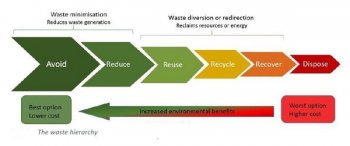
Environmental and horticultural research consultant, David Hunt, recently carried out an investigation of the economics of changing waste management practices, and developed a number of digital resources to help production nurseries conduct an assessment.
“In the past, it was considered acceptable to dispose of waste by burying it in landfill," he said. “Now, as technology, packaging and community attitudes change, waste management and disposal have become a crucial part of running a successful nursery.
“Embracing new waste management practices and alternative waste disposal options can reduce waste disposal costs for nurseries, no matter their size. This approach can increase resource use efficiency and also boost the business’s ‘green credentials’, or marketing image.
“There are a variety of reuse and recycling programs available, particularly of late, as environmental sustainability continues to be an important topic.”
Hunt says the first step for nursery managers looking to adopt better waste management procedures is to conduct an assessment of the types of waste, and respective quantities, which contribute the most to the nursery’s waste costs. He suggests that all business and production processes will generate waste in some form.
According to Hunt, there are a few key ways to reduce the amount of waste generated, and therefore disposal costs:
- Limit the quantity of waste being imported into the business as packaging and unnecessary items;
- Purchase in bulk and assess packaging for its recycling value or reuse potential – this may reduce purchase costs, as well;
- Separate and divert materials from general waste to recycling or reuse.
Hunt’s research in the field revealed that accounting records may not represent the true cost of waste management, and embracing new waste management practices can reduce costs.
“Many ‘wastes’ are actually a resource that can be recycled, redirected, or remanufactured for other uses,” he said. “Conducting an onsite waste assessment and investigating local recycling services will help to identify which waste materials can be targeted for alternative practices and what options will provide the best results.
“This not only reduces the pressure on using more raw materials, but also supports the development of recycling infrastructure and a market for used materials.”
Hunt said that while it may not always be possible to find a solution for all materials in all locations, recycling services are constantly growing. Nursery managers should also consider other businesses in the local area, for example:
- Neighbouring businesses that could use discarded packaging;
- Neighbouring businesses that produce similar waste and may agree to a bin-share agreement;
- Landscaping businesses that could use greenwaste for compost.
Hunt believes nursery managers should reassess their waste situation annually, or whenever their production processes change. Material that is considered as a throwaway waste product one year may be in demand by a local business or waste management company the next year.
“For a sustainable future, the nursery industry needs to purchase products made from recycled materials, encourage the ongoing development of waste recycling services, and change the way waste materials are valued.”
The project included the development of several resources to help nurseries conduct an assessment, which can be found on the Nursery and Garden Industry Australia website: www.ngia.com.au.
The project, ‘Assessing waste streams in Australian production nurseries’ (NY13003), was funded by Horticulture Innovation Australia using nursery industry levies and funds from the Australian Government.
Source: NGIA



 Classifieds
Classifieds

